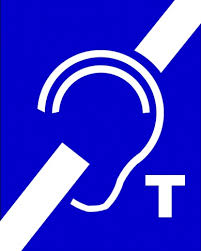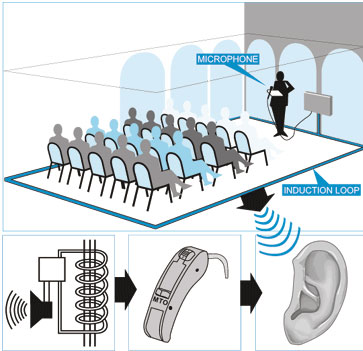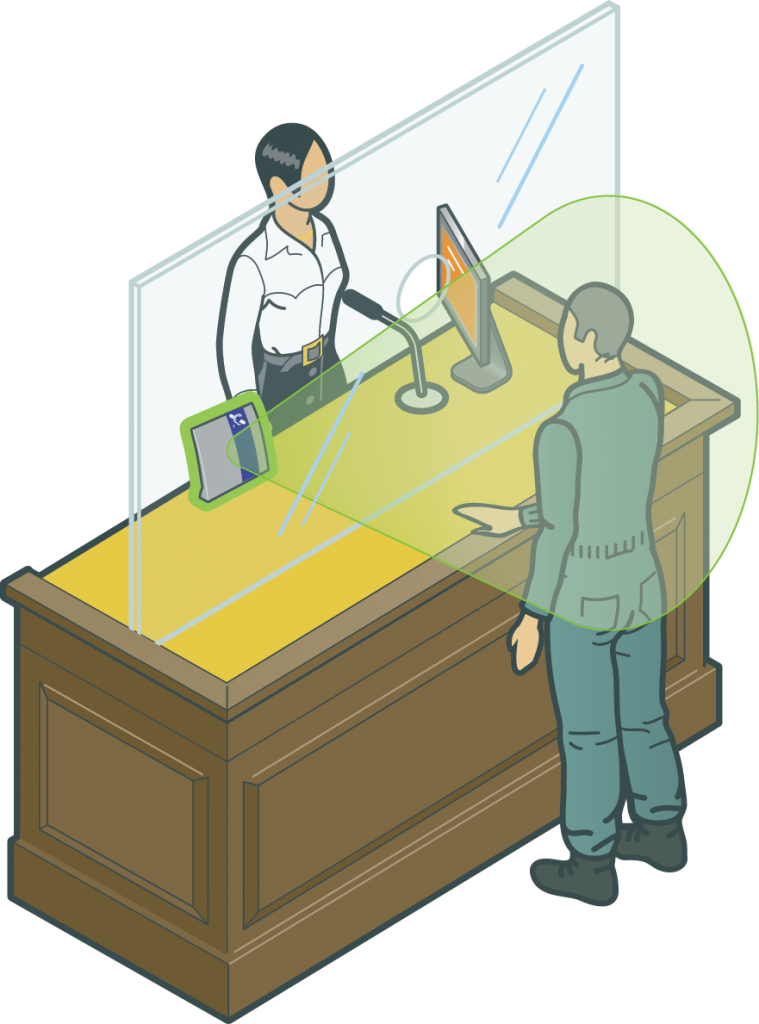Is Induction Loop Technology Old News?
 An Induction Loop is analogue technology that has been around since the 1940s. Is it still a viable option for assistive listening in today’s digital world? Does it have any advantages over FM, infrared, and Bluetooth solutions?
An Induction Loop is analogue technology that has been around since the 1940s. Is it still a viable option for assistive listening in today’s digital world? Does it have any advantages over FM, infrared, and Bluetooth solutions?
What exactly is an Induction Loop? In simple terms, it is a system that allows electronic audio sources to be wirelessly connected to a hearing aid's built-in T-coil receiver, also known as a telecoil (from “telephone coil”). At present, approximately 75% of hearing aids and all cochlear implants have the T-coil receiver built in. An Induction Loop system wirelessly transmits magnetic energy to the telecoil-equipped hearing aid using a wire that surrounds a counter or room. When a sound source is transmitted through a Loop, the telecoil circuit inside the hearing aid receives that source directly, without background noise from the room, making it much more intelligible to the person with the hearing aid.
Example of a simple room loop.
With all wireless assistive listening systems there needs to be an audio source that is sent to a transmitter. The original audio source can come from a microphone, TV, public address system or theatre playback – basically any electronic source. In the case of an Induction Loop, the signal is transmitted as a magnetic field by a wire (antenna) surrounding a given area and picked up through the T-coil in the hearing-aid.
With FM technology, the signal from the microphone or other audio source is converted to an FM radio signal, and received by anyone with an FM receiver dialed in to pick up that frequency. The benefits of FM technology are that the infrastructure takes little installation and will broadcast a great distance; even through walls. This is very useful where security isn’t an issue but is not acceptable when trying to contain information within a particular space – a courtroom, for example.
This is where infrared (“I/R”) technology excels. I/R systems use infrared light to send an audio signal from a transmitter to a receiver. This technology relies on the same type of light that your remote control uses to control your TV. Like FM, I/R requires little installation and can be configured to cover a very large area. Unlike FM, because I/R uses light, it cannot transmit through walls, which makes it ideal for locations where security is an issue.
The downside with both FM and I/R is that they require a separate device, a receiver, to pick-up the signal being transmitted. The receiver is not built into the hearing aid as it is in case of the T-coil. For this reason, a person who wishes to use the system would need to obtain a personal FM or I/R receiver.
Are there situations where Induction Loop technology is not practical or feasible? Absolutely. Installation of the loop wire can be challenging if it is to be retrofitted into an existing room as opposed to installed during a new build or a major renovation. In most cases a loop wire running the perimeter of the room will provide the required magnet field to satisfy the IEC standard for Induction Loops (IEC 60118-4), but in buildings constructed using a large amount of metal, which affects the efficiency of the magnetic transmission, a “phased loop system” is required. A phased system consists of an array of loops zig-zagging across the floor using flat copper tape. The floor covering is then installed over the copper foil. This system produces an extremely consistent magnet field, and also prevents the magnetic field from spilling out of the room so can be used for high security applications. The other potential issue with Loop technology is that the T-coil in the hearing aid can pick-up magnetic interference from improperly installed wiring, old lighting fixtures, dimmer switches and low frequency fluorescent lighting ballasts. Most of these issues can be resolved, but a qualified Loop installer must do a site visit and check the location for background magnetic interference before an Induction Loop should be considered.

Vancity: Vancouver City Savings Credit Union
In some parts of the world, the UK for example, assistive listening technology has actually been legislated in order to provide accessibility to all people. In Europe and the US, Induction Loops continue to gain in popularity as a result of their simplicity and effectiveness. In Canada, people are starting to hear about this technology. Many businesses are beginning to recognize the importance of serving their clientele by providing Loops in their facilities. Vancity (Vancouver City Savings Credit Union) was the first financial institution in Canada to install Induction Loops at the teller wickets in all of their branches. As a result of their “teller loop” installations, Vancity received the “Access & Inclusion Award 2013” which recognizes individuals and organizations who promote activities that enhance accessibility and inclusion of people with disabilities in all aspects of community life. More recently BC Ferries Corporation got on-board by having Induction Loops installed on several of their ships and have announced that all new-builds and re-fitted older ships will have Loops installed.

Example of a portable teller loop.
There’s an ever-increasing desire at all levels of government to make Canada more accessible. Ontario’s “Ontarians with Disabilities Act” is leading the way with BC’s Accessibility 2024 initiative promising monumental improvements in the way those with disabilities are included in all areas of life. The Government of Canada is itself currently drafting the country’s first National Disability Act. There are many grant programs set up to help make public places more accessible. For example, the “Enabling Accessibility Fund is a federal Grants and Contributions program that supports capital costs of construction and renovation related to improving physical accessibility and safety for people with disabilities in Canadian communities and work places”... specifically including Induction Loop systems.
In conclusion, assistive listening systems are the hearing-aid user’s best friends. All of these technologies have their pros and cons and each has its place. Bluetooth is available in many hearing aids and is excellent for personal streaming. FM broadcasts a great distance but requires the use of a separate receiver. I/R uses infrared light to send its signal, which can be contained within a room, but again requires the use of a separate receiver by the user. And then there’s the grandfather of them all: The Induction Loop system. With the “T-coil” receiver already built into most hearing aids and no frequency to change or “pairing” required, the Induction Loop is still the universal standard. It continues to be the most practical, convenient and reliable system available for assistive listening in public places. With the relatively low costs of these systems and funding available, there really is no reason why Induction Loop systems shouldn’t be installed in all applicable locations; starting with the hub of the hard of hearing’s resource network: their audiologist’s office. Having an Induction Loop available is the most effective way for an audiologist to demonstrate their clients’ T-coil and educate them on its use.

